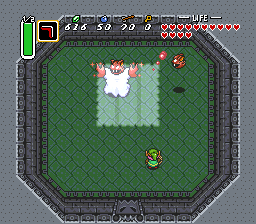Zelda Moments: Fooled by Blind the Thief
Posted on October 29 2013 by Axle D. Wilder
 A Link to the Past was the first Zelda game to really bring a running plot to the game itself — as opposed to just a simple backstory to explain why the heck you’re collecting triangles or jewels or whatever — but it’s still not regarded as a story-heavy game. Different events happen throughout and there’s dialogue, and plenty of the moments are even quite cinematic and epic in their own way, but it’s still not a game with a really deep story, great characterization, or complicated motivations. That said… somehow it still had a certain phenomenon that we still rarely see even in the plot-heavy modern titles: A non-villain boss that’s his own character with his own dialogue and buildup.
A Link to the Past was the first Zelda game to really bring a running plot to the game itself — as opposed to just a simple backstory to explain why the heck you’re collecting triangles or jewels or whatever — but it’s still not regarded as a story-heavy game. Different events happen throughout and there’s dialogue, and plenty of the moments are even quite cinematic and epic in their own way, but it’s still not a game with a really deep story, great characterization, or complicated motivations. That said… somehow it still had a certain phenomenon that we still rarely see even in the plot-heavy modern titles: A non-villain boss that’s his own character with his own dialogue and buildup.
While Agahnim and Ganon were both major villains and thus had the appropriate amount of story and buildup, Blind was just a lowly dungeon boss with no real effect on the overall story or game… and yet Nintendo saw fit to build him up quite a bit!
A random house in Kakariko Village is declared his ex-hideout…
Zelda warns you of his trickery specifically…
And Blind himself is encountered and even conversed with before fighting him, albeit in disguise as the maiden you’re trying to save, before his true form is revealed in the light!
Gyaaah! Too bright!
 It’s definitely not much in comparison to the storytelling in recent Zelda games, and dungeon bosses like Ghirahim got similar treatment but had even more detailed story and dialogue surrounding their appearances (granted, Ghirahim was a major villain in the story as well). But this was back then, man! The Super Nintendo days! Proportionally, Blind’s history and moments are almost as much compared to the rest of the story and lore in A Link to the Past as Ganondorf’s is to the rest of the story in The Wind Waker! Okay, probably not that much. Still, you get the point: For the time, this was a huge role for a boss that wasn’t the main villain, and a lot of time spent on one.
It’s definitely not much in comparison to the storytelling in recent Zelda games, and dungeon bosses like Ghirahim got similar treatment but had even more detailed story and dialogue surrounding their appearances (granted, Ghirahim was a major villain in the story as well). But this was back then, man! The Super Nintendo days! Proportionally, Blind’s history and moments are almost as much compared to the rest of the story and lore in A Link to the Past as Ganondorf’s is to the rest of the story in The Wind Waker! Okay, probably not that much. Still, you get the point: For the time, this was a huge role for a boss that wasn’t the main villain, and a lot of time spent on one.
I’ve talked in the past of really enjoying the Monkeys in the Forest Temple or Yeto and Yeta in Snowpeak Ruins in Twilight Princess, and of all my reasons, especially because they created a running story within their dungeons — however minor they might have been — and gave you characters to interact with to make the dungeons feel like something a bit more than just gameplay spaces. On the opposite end of the spectrum — foe as opposed to friend — I think Blind serves the same purpose for Gargoyle’s Domain in A Link to the Past. Interacting with the false maiden, even if that only means meeting her and leading her around, after hearing Blind’s story in Kakariko earlier in the game and Zelda’s warning about his deception, has a great effect, and unveiling Blind’s true form is much the same; it feels very different luring the false maiden into the light in the boss room to reveal Blind’s true form instead of just wandering in and finding the boss there, and it’s a great moment.
I’d love to see more characters like Blind. Not just like with Agahnim, Ghirahim, and even Yuga, where they have major parts in the overarching story and just happen to be fought in dungeons as well. Certainly, those types of dungeon bosses can exist too, but what I’m talking about are characters who are just dungeon bosses but have some amount of characterization or history… anything at all really… to give them some presence in the world. Skyward Sword did this in a way with Moldarach and Scervo, as did Ocarina of Time with Phantom Ganon, so it’s not like it’s not something we’ve never seen since A Link to the Past… but just the same it’s a cool idea that I still mainly associate with that game, and I can’t get enough of it.

So how about you? Was Blind memorable to you? Do you like how he was handled as a simple dungeon boss and minor villain? Do you think cases like Ghirahim, or even Moldarach, are similar? And would you like to see stuff like this more often? Tell me in the comments!



